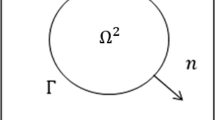Abstract
A Boundary Element Method has been developed for solving nonlinear boundary-value problems. This method avoids the tedious calculation of the domain integral contributions to the boundary integral equations. This is achieved by applying approximate particular solutions which are obtained by expressing the “pseudo-body force” in terms of a linear combination of radial basis functions. Numerical examples show that the method is efficient and can produce accurate results.
Similar content being viewed by others
References
Abramowitz M.; Stegun A. (1972): Handbook of mathematical functions, New York: Dover Publications, Inc.
Ahmad S.; Banerjee P. K. (1986): Free vibration analysis by BEM using particular integrals. J. Eng. Mech. ASCE, 112, 682–695
Azevedo, J. P. S.; Brebbia, C. A. (1988): An efficient technique for reducing domain integral to the boundary. Proc. of the X int. Conf. on BEM in Eng. 347–361
Bachelor G. K. (1967). An introduction to fluid dynamics, Cambridge University Press, Great Britain
Banerjee P. K.; Ahmad S.; Wang H. C. (1988): A new BEM formulation for the acoustic eigenfrequency analysis. Int. J. Num. Meth. Engng. 26, 1299–1309
Beverly, C. (1990): Private communication
Brebbia C. A. (ed) (1980): The boundary element method for engineers, 2nd ed., Pentech Press, Great Britain
Bush M. B.; Tanner R. I. (1983): Numerical solution of viscous flows using integral equation methods. Int. J. Num. Meth. Fluids. 3, 71–92
Coleman, C. J. (1990): A boundary element approach to some nonlinear equations from fluid mechanics. To appear in Computational Mechanics.
Danson D. J. (1981): A boundary element formulation of problems in linear isotropic elasticity with boday forces. In: Brebbia C. A. (Ed.): Boundary element methods. Berlin, Heidelberg, New York: Springer
Gartling D. K.; Nickell R. E.; Tanner R. I. (1977). A finite element convergence study for accelerating flow problems. Int. J. Num. Meth. Eng. 11, 1155–1174
Herry D. P.Jr.; Banerjee P. K. (1988a): A new boundary element formulation for two-and three-dimensional thermoelasticity using particular integrals. Int. J. Numer. Meth. Engng, 26, 2061–2978
Herry D. P.Jr.; Banerjee P. K. (1988b): A new BEM formulation for two-and three-dimensional elastoplasticity using particular integrals. Int. J. Numer. Meth. Engng, 26, 2079–2098
Little R. (1973): Elasticity, Prentice-Hall, U.S.A.
Nardini D.; Brebbia C. A. (1982): A new approach to free viberation analysis using boundary elements. In: Brebbia C. A. (ed): Boundary element methods in engineering, Berlin, Heidelberg, New York: Springer
Nickell R. E.; Tanner R. I.; Caswell B. (1974): The solution of viscous incompressible jet and free-surface flows using finite element methods. J. Fluid Mech. 65, 189–206
Omodei B. J. (1979): Computer solution of a plane Newtonian jet with surface tension. Computer and Fluids 7, 79–96
Powell M. J. D. (1987): Radial basis functions for multivariate interpolation. In: Mason J. C.; Cox M. G. (eds). Algorithms for approximation, Oxford: Clarendon Press
Rizzo F. J.; Shippy D. J. (1977): An advanced boundary integral equation method for three-dimensional thermoelasticity, Int. J. Num. Meth. Engng. 11, 1753–1768
Rosenhead L. (ed) (1963): Laminar boundary layers, Oxford University Press, Great Britain
Saigal S.; Gupta A.; Cheng J. (1990): Stepwise linear regression particular integrals for uncoupled thermoelasticity with boundary elements. Int. J. Solids Struct. 26, 471–482
Stippes M.; Rizzo F. J. (1977): A note on the body force integral of classical elastostatics. ZAMP, 28, 339–341
Stoer J.; Bulirsch R. (1976): Introduction to numerical analysis. Berlin, Heidelberg, New York: Springer
Tang W. (1988): Transforming domain into boundary integrals in BEM, vol. 35, New York: Springer-Verlag
Tanner R. I. (1988): Engineering rheology. Revised paperback edition, Oxford: Clarendon Press
Wilson R. B.; Miller N. M.; Banerjee P. K. (1990): Free-vibration analysis of three-dimensional solids by BEM. Int. J. Numer, Meth. Engng. 29, 1737–1757
Zheng, R.; Coleman, C. J.; Phan-Thien, N. (1990): A boundary element approach for non-homogeneous potential problems. To appear in Computational Mechanics
Zheng R.; Tanner R. L. (1989): A boundary element method for free surface flow problems. In: Hogarth W. L.; Noye B. J. (eds): Computational techniques and applications: CTAC-89. Hemisphere Publishing Corporation, New York
Author information
Authors and Affiliations
Additional information
Communicated by S. N. Atluri, December 7, 1990
Rights and permissions
About this article
Cite this article
Zheng, R., Phan-Thien, N. & Coleman, C.J. A boundary element approach for non-linear boundary-value problems. Computational Mechanics 8, 71–86 (1991). https://doi.org/10.1007/BF00350612
Issue Date:
DOI: https://doi.org/10.1007/BF00350612




